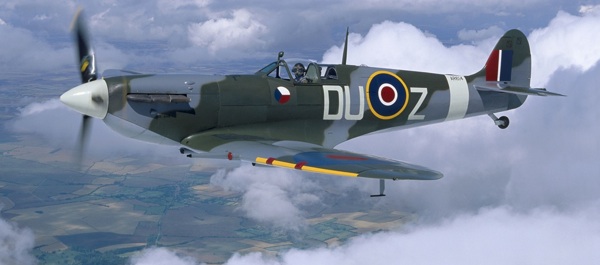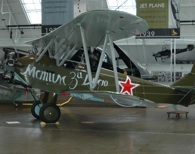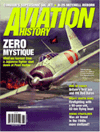Flying Heritage Collection Preserves and Flies WWII Aircraft

Our rarest is a Nakajima Ki-43 Oscar. It’s the best preserved one anywhere.
If you’re passing through Everett, Washington, on sunny days in spring or summer, don’t be surprised if you see a P-51 Mustang flying by. Or a British Spitfire. Or maybe a Messerschmitt or any of a number of other aircraft from World War II.
Everett is home to the Flying Heritage Collection, an incredible personal collection of vintage aircraft that the owner likes to share with the public. Year-round, these winged veterans of World War II are on display in the FHC Museum, but many have been restored to flying condition, and when weather permits during the warmer months, they take to the skies again.
{default}In an exclusive interview with ArmchairGeneral.com, the museum’s executive director, Adrian Hunt, explained how this unique opportunity to visit the past came about.
ArmchairGeneral.com: What is the Flying Heritage Collection?
Adrian Hunt: It’s a magnificent collection of both iconic and rare aircraft, showcasing some of World War II’s greatest hits.
It began as the private collection of Microsoft co-founder Paul G. Allen in 1975. He is a major philanthropist and supporter of museums, among other things. This is a beautiful collection of WWII aircraft, restored to excellent condition—in most cases flying condition. He wants the public to experience these planes as they could have 60 years ago.
Every care is taken to obtain original parts when we’re restoring a plane. If we are unable to obtain original parts, we use materials identical to those used originally. With a plane covered in fabric, for example, we use the same material with the same number of threads as that of the original aircraft. It is arguably the greatest private collection of aircraft in this condition.
ACG: How did it get started?
AH: Paul Allen has always been interested in museums and in sharing his collection with the public. He amassed this collection over 10 years. I don’t think the plan was ever to just collect them and store them somewhere; I think sharing them was always in the back of his mind. He is involved with several other museums, not just ones related to aircraft.
ACG: Such as?
 AH: He has a large music museum called EMP, Experience Music Project. It is incredibly interactive, with a fantastic collection of vintage instruments. There’s a whole area where you can learn to use musical instruments. It basically talks you through simple ways to play guitar, for example, with lights on the strings to show you how to play.
AH: He has a large music museum called EMP, Experience Music Project. It is incredibly interactive, with a fantastic collection of vintage instruments. There’s a whole area where you can learn to use musical instruments. It basically talks you through simple ways to play guitar, for example, with lights on the strings to show you how to play.
He also sponsors the Science Fiction Museum and Hall of Fame. It has a large collection of artifacts of materials associated with science fiction—books, movie costumes, artwork. Captain Kirk’s chair from the original Star Trek series is in that museum.
Both EMP and the Science Fiction Museum are in Seattle, but he is also the benefactor of a computer science exhibit in Albuquerque, New Mexico, at the New Mexico Museum of Natural History.
ACG: Did all the aircraft in the Flying Heritage Collection actually fly in World War II?
AH: We do have a Curtiss Jenny from 1918, but all others are from World War II, and most served in the war. We have two aircraft that did not see combat, a P-40 Thunderbolt and a Hellcat.
We have American, British, German, Russian and Japanese aircraft.
ACG: Japanese planes of World War II are pretty rare.
AH: They’re really rare. The American troops basically destroyed what wasn’t lost in the war, and wrecks in the humid Pacific climate didn’t survive very well.
Our rarest is a Nakajima Ki-43 Oscar. It’s the best preserved one anywhere. It was rescued at the end of the war by a New Zealand officer who found it hidden in the jungle where it wouldn’t get bombed. He took some parts from other aircraft to repair it.
ACG: What are some of the most popular planes?
AH: We have a lot of interesting aircraft. One big favorite is the P-51 Mustang we have, which flew in Europe at end of war. It had several kills, including an Me262 jet fighter. We have a video taken with the man who flew the plane then, visiting it here at the museum.
Another plane that always attracts attention is the Messerschmitt Bf109E-3 Emil with original engine. This is a Battle of Britain vintage craft.
We also have a V-1 flying bomb and a manned V-1 rocket—a cockpit was mounted on a V-1, which was basically a huge bomb with an engine on the back of it, so that a pilot could guide it for greater accuracy. It would have been a suicide weapon if it had ever been used.
 Another of our unusual aircraft is a Polikarpov 303 Russian plane. Those were used by women bomber pilots (called the Night Witches by the Germans—ACG) and serviced by female ground crews. We have a video about the courageous 18, 19-year-old women who flew these antique, out-of-date biplanes. They had to fly at night on their bombing missions to avoid the Luftwaffe.
Another of our unusual aircraft is a Polikarpov 303 Russian plane. Those were used by women bomber pilots (called the Night Witches by the Germans—ACG) and serviced by female ground crews. We have a video about the courageous 18, 19-year-old women who flew these antique, out-of-date biplanes. They had to fly at night on their bombing missions to avoid the Luftwaffe.
We have several video kiosks with oral histories like the one of the Russian women night bombers and the pilot who flew the P-51 we have. We have several histories from pilots who flew craft similar to the ones we have in collection.
ACG: I believe you also have a Homefront display as part of the museum, to put the collection into a social and political perspective as well as a military one.
AH: That’s right. We’re interested in the context of things, so we have these areas where we talk about what was happening at home with long photomontages and text talking about what was going on in the U.S., England, Germany, Russia. Our other exhibits are written in past tense, but these are in present tense to try to catch the feel of a newsreel of the time, to try to give a feel of what actually happened in these countries during this tumultuous time.
ACG: The town of Everett is close to the Pacific Coast in Washington. Does the moist climate there pose special challenges in maintaining the aircraft?
AH: We treat them very carefully. We don’t let them get wet. We only fly in spring and summer, usually May to September. The rest of the year, we have plenty of maintenance work to do.
ACG: When are the flying days held?
AH: Generally every two weeks in spring and summer, in the middle of day. We fly two planes. The main airport sets aside a space for us to have the flights. Beforehand, we open the hangar doors and introduce people to the planes and pilots that will fly that day.
We treat these planes with a lot of respect. We don’t do loop-the-loop and fancy maneuvers, mostly fly-bys. We don’t want to treat these as entertainment objects. We want to do this to honor the technology and the veterans who flew them.
Not all the planes fly. For instance, we have an Me163 rocket plane that always attracts attention. It was very fast, very dangerous to fly. It was the cutting edge of German technology.
ACG: How is the collection made available to the public, apart from the flying days?
AH: We’re open 7 days a week in summer. In winter, we’re closed on Mondays. Other than that, we’re open all but Thanksgiving and Christmas days.
ACG: Are there possibilities for the collection to expand, or it is unlikely additional aircraft will be found that collectors or others are willing to part with?
AH: Oh, no. We’re always looking. We have some aircraft now that are being restored to their original condition. The collection will grow as we add more planes.
 For more articles on vintage aircraft, check out the archives at Aviation History magazine.
For more articles on vintage aircraft, check out the archives at Aviation History magazine.


I noted that AH identified a P-40 Thunderbolt. Probably a typo as I’m sure he knows the Thunderbolt is a P-47. I Think the P40
of Flying Tigers fame was designated Warhawk or something similar. It was manufactured by Curtiss whereas the Thunderbolt was a Republic production , a real ground support strafing machine, a huge fighter plane.
I have rare ww2 training books for pilots that I’m selling. If you
know anyone interested please contact Dale at 7042091322
thank you!!!